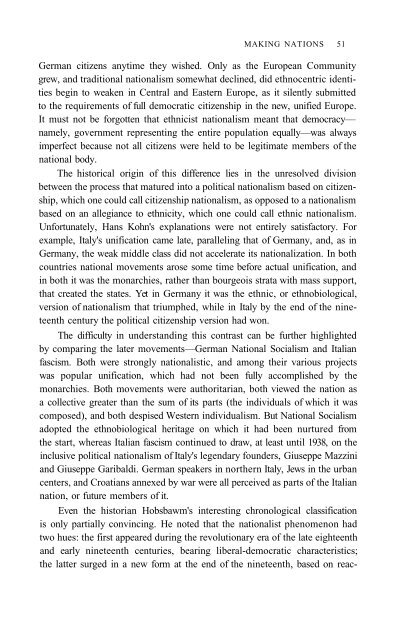Shlomo Sand, The Invention of the Jewish People - Rafapal
Shlomo Sand, The Invention of the Jewish People - Rafapal
Shlomo Sand, The Invention of the Jewish People - Rafapal
Create successful ePaper yourself
Turn your PDF publications into a flip-book with our unique Google optimized e-Paper software.
MAKING NATIONS 51<br />
German citizens anytime <strong>the</strong>y wished. Only as <strong>the</strong> European Community<br />
grew, and traditional nationalism somewhat declined, did ethnocentric identities<br />
begin to weaken in Central and Eastern Europe, as it silently submitted<br />
to <strong>the</strong> requirements <strong>of</strong> full democratic citizenship in <strong>the</strong> new, unified Europe.<br />
It must not be forgotten that ethnicist nationalism meant that democracy—<br />
namely, government representing <strong>the</strong> entire population equally—was always<br />
imperfect because not all citizens were held to be legitimate members <strong>of</strong> <strong>the</strong><br />
national body.<br />
<strong>The</strong> historical origin <strong>of</strong> this difference lies in <strong>the</strong> unresolved division<br />
between <strong>the</strong> process that matured into a political nationalism based on citizenship,<br />
which one could call citizenship nationalism, as opposed to a nationalism<br />
based on an allegiance to ethnicity, which one could call ethnic nationalism.<br />
Unfortunately, Hans Kohn's explanations were not entirely satisfactory. For<br />
example, Italy's unification came late, paralleling that <strong>of</strong> Germany, and, as in<br />
Germany, <strong>the</strong> weak middle class did not accelerate its nationalization. In both<br />
countries national movements arose some time before actual unification, and<br />
in both it was <strong>the</strong> monarchies, ra<strong>the</strong>r than bourgeois strata with mass support,<br />
that created <strong>the</strong> states. Yet in Germany it was <strong>the</strong> ethnic, or ethnobiological,<br />
version <strong>of</strong> nationalism that triumphed, while in Italy by <strong>the</strong> end <strong>of</strong> <strong>the</strong> nineteenth<br />
century <strong>the</strong> political citizenship version had won.<br />
<strong>The</strong> difficulty in understanding this contrast can be fur<strong>the</strong>r highlighted<br />
by comparing <strong>the</strong> later movements—German National Socialism and Italian<br />
fascism. Both were strongly nationalistic, and among <strong>the</strong>ir various projects<br />
was popular unification, which had not been fully accomplished by <strong>the</strong><br />
monarchies. Both movements were authoritarian, both viewed <strong>the</strong> nation as<br />
a collective greater than <strong>the</strong> sum <strong>of</strong> its parts (<strong>the</strong> individuals <strong>of</strong> which it was<br />
composed), and both despised Western individualism. But National Socialism<br />
adopted <strong>the</strong> ethnobiological heritage on which it had been nurtured from<br />
<strong>the</strong> start, whereas Italian fascism continued to draw, at least until 1938, on <strong>the</strong><br />
inclusive political nationalism <strong>of</strong> Italy's legendary founders, Giuseppe Mazzini<br />
and Giuseppe Garibaldi. German speakers in nor<strong>the</strong>rn Italy, Jews in <strong>the</strong> urban<br />
centers, and Croatians annexed by war were all perceived as parts <strong>of</strong> <strong>the</strong> Italian<br />
nation, or future members <strong>of</strong> it.<br />
Even <strong>the</strong> historian Hobsbawm's interesting chronological classification<br />
is only partially convincing. He noted that <strong>the</strong> nationalist phenomenon had<br />
two hues: <strong>the</strong> first appeared during <strong>the</strong> revolutionary era <strong>of</strong> <strong>the</strong> late eighteenth<br />
and early nineteenth centuries, bearing liberal-democratic characteristics;<br />
<strong>the</strong> latter surged in a new form at <strong>the</strong> end <strong>of</strong> <strong>the</strong> nineteenth, based on reac-




